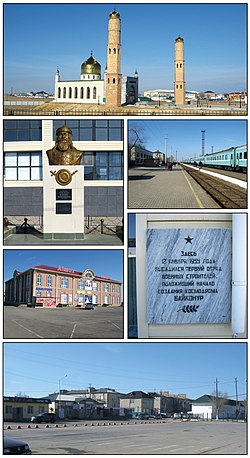Tyuratam

Tyuratam (Kazakh: Төретам, Tóretam; Russian: Тюратам, Tyuratam) is a station on the main Moscow to Tashkent railway, located in Kazakhstan. The name is a word in the Kazakh language and means "Tóre's grave"; Tóre, or more formally, Tóre-Baba, was a noble, a descendant of Genghis Khan. Tyuratam is near the Baikonur Cosmodrome, a Russian – formerly Soviet – spaceport, and near the city of Baikonur (formerly Leninsk), which was constructed to service the cosmodrome.
History[]
In the mid 1950s, the Soviet Union announced that space activities were being conducted from the Baikonur Cosmodrome, which was assumed to be near the city of Baikonur, in the Kazakh SSR. In reality, the launch facilities were located 400 kilometres (250 mi) to the southwest at Tyuratam near the city of Leninsk (commonly referred to as Baikonur, after the cosmodrome).[1] At a press conference for the Apollo-Soyuz Test Project, Jules Bergman of ABC News said,
Baikonur, if you'll look on the coordinates, is 135 miles [217 km] away or something. Tyuratam may only be a railhead, but it is the Tyuratam Launch Complex. They call it Baikonur, I know. . . . I'm going to call it Tyuratam. ABC is going to call it Tyuratam. SAC Strategic Air Command calls it Tyuratam. Can we once and for all straighten that out and arrive at a . . . name for it, Tom?[2]
While many reporters thought that the Soviets were calling it Baikonur to hide its true location, it turned out that the confusion arises from the fact that there is another city called Baikonur, some 400 kilometres (250 mi) to the northeast of the Baikonur Cosmodrome at Leninsk (which was commonly referred to as just Baikonur). Deke Slayton mentioned that if they really wanted to use the name the Soviets commonly used, they would have to say Baikonur.[2]
The CIA tried to locate this launch site by systematically tracking over the major rail networks of the Soviet Union in Central Asia with U-2 spy planes. The site was discovered and photographed in 1957. Francis Gary Powers was scheduled to fly over it on his ill-fated mission in 1960. A Russian source has speculated incorrectly that he may have avoided Tyuratam after detecting the guidance radar of the defending SA-2 missile battery. [3] At that time U-2 pilots had no real-time SAM radar warning. In fact Powers was off track due to navigational inaccuracy caused by a delayed take-off which rendered his pre-computed astronavigation fixes inaccurate, and cloud cover which hampered visual track correction.[4] It also prevented him from photographing the site. He was later shot down over Sverdlovsk.
References[]
- ^ Pike, John. "Baikonur Cosmodrome 45.9 N 63.3 E, Tyuratam– Overview, Supporting Facilities and Launch Vehicles of the Soviet Space Program, The 1971–1975 study". GlobalSecurity.org. mypressplus.com. Retrieved 30 April 2016.
- ^ a b NASA. "The Partnership: A History of the Apollo-Soyuz Test Project". NASA.
- ^ Zak, Anatoly. "Secrecy around Baikonur". Russian Space Web. Anatoly Zak. Retrieved 30 April 2016.
- ^ Powers, Francis; Gentry, Curt (1970). Operation Overflight: The U-2 spy pilot tells his story for the first time. Holt, Rinehart and Winston. pp. 78–80. SBN 03-083045-1.
Further reading[]
Mike Gruntman (2019), "From Tyuratam Missile Range to Baikonur Cosmodrome", Acta Astronautica, Elsevier Ltd, 155: 350–366, Bibcode:2019AcAau.155..350G, doi:10.1016/j.actaastro.2018.12.021
External links[]
Coordinates: 45°39′00″N 63°18′50″E / 45.65000°N 63.31389°E
- Populated places in Kazakhstan
- Populated places in Kyzylorda Region

